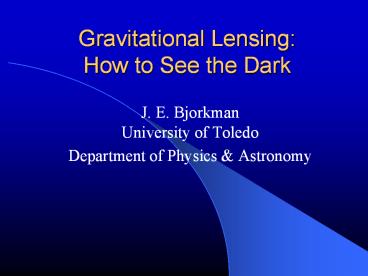Gravitational Lensing: How to See the Dark - PowerPoint PPT Presentation
1 / 36
Title:
Gravitational Lensing: How to See the Dark
Description:
Title: PowerPoint Presentation Author: Jon Bjorkman Last modified by: Jon Bjorkman Created Date: 5/2/2002 9:52:27 PM Document presentation format – PowerPoint PPT presentation
Number of Views:153
Avg rating:3.0/5.0
Title: Gravitational Lensing: How to See the Dark
1
Gravitational Lensing How to See the Dark
- J. E. BjorkmanUniversity of Toledo
- Department of Physics Astronomy
2
The Dark Between the Light
3
Dark Matter
- How do we know its there?
- Answer It affects the motion of everything we
can see. - Cluster Simulation
- Rotation Velocities
4
Galactic Rotation Curves
5
Missing Mass in our Galaxy
6
What is the Dark?
- MACHOs (Massive Compact Halo Objects)
- low mass stars - "brown dwarves"
- "almost" stars (planets, e.g. Jupiters)
- black holes of less than solar mass
- The VW graveyard
- WIMPs (Weakly Interacting Massive Particles)
- heavy neutrinos (10 to 1000 GeV)
- new particles predicted by Supersymmetry -
'neutralinos' - exotic particles e.g. axions (particles with
mass lt 0.1 eV) - Modified Gravity - on galactic scales.
7
Where is the Dark?
8
Gravity Bends Light (Einstien)
9
Gravitational Lenses
10
Einstein tells Eddington gravity bends starlight.
11
Eclipse Astrometry
- How do we know the stars moved?
12
Relativity Verified
13
Discovery of a Gravitational Lens
14
Galaxies as Lenses
15
A Lensing Simulation
16
A Lens Gallery
17
Galaxy Clusters as Lenses
18
Measuring the Dark
- 0.5 of Universe is luminous
- 99.5 of Universe is dark matter
19
Stellar LensesOrion behind a Black Hole
20
Gravitational Microlenses
- What are microlenses?
- Stellar mass (or smaller) lenses
- Images are unresovled (milliarcsecond separation)
- Lens focuses light
- Object appears brighter (several magnitudes!)
- Thats absurd!
- Youll never see one in a million years!
- Answer just look at million stars every night!
21
Microlensing Searches
- Toward the Magellanic Clouds
- MACHO (MAssive CompactHalo Objects collaboration)
- EROS (Experience pour la Recherche d'Objets
sombres) - DUO (Disk Unseen Objects)
- Toward the Galactic Bulge
- OGLE (Optical Gravitational Lensing Experiment)
- Toward M31
- AGAPE (Andromeda Galaxy Amplified Pixel
Experiment) - MEGA
22
Ogling the Stars
23
AGAPE at M31
24
Looking Through a Lens
25
A Lens in Motion
26
What You Really See
27
Looking for Lenses in Haystacks
28
Frequency of Events
29
How Big is the Lens? How Close did it get?
30
What are They?
31
Follow-Up Monitoring
- PLANET (Probing Lensing Anomalies NETwork)
- Garching Spectroscopic Monitoring Group
- GMAN (Global Microlensing Alert Network)
- MPS (Microlensing Planet Search Project)
- MOA (Microlensing Observations in Astrophysics)
32
Looking Through BifocalsBinary Stars as Lenses
33
Binary Stars as Lenses
34
Looking for Planets
35
The Planet Search
36
Micolensing Results
- They Exist! Future surveys will detect 1/day
- Fewer than expected toward LMC/SMC
- 50 of halo may be Machos (M 0.5Msun)
- More than expected toward Galactic center
- Masses are few 0.1 Msun
- May indicate presence of bar (i.e., Milky Way is
a barred spiral) - About 10 are binary events
- Planets
- No definite detections, yet
- Fewer that 1/3 of lenses have Jupiter-mass
planets at 1-4 AU































